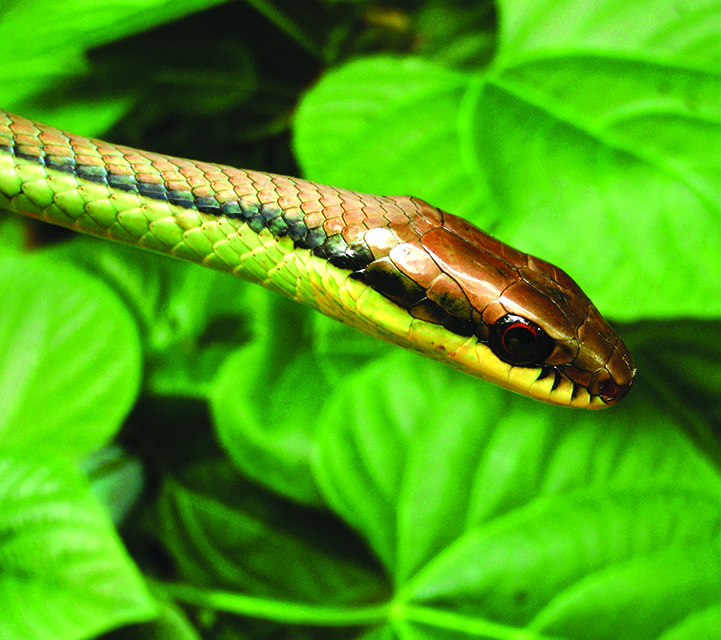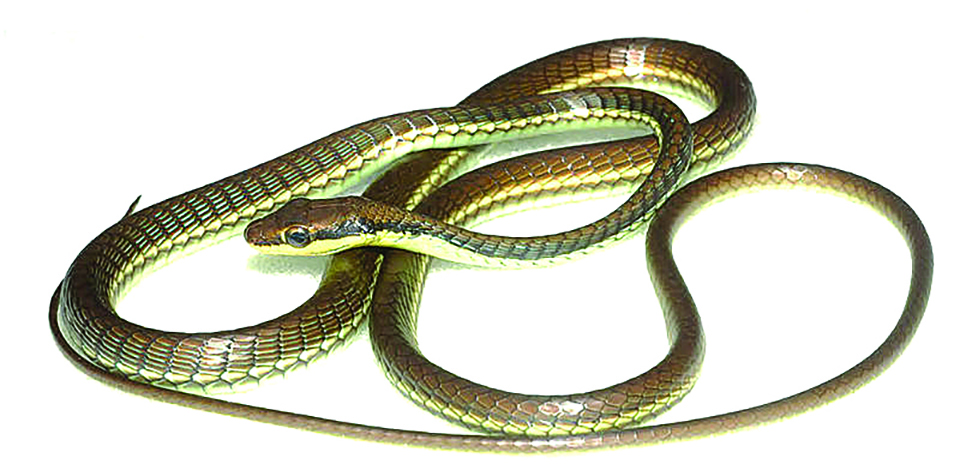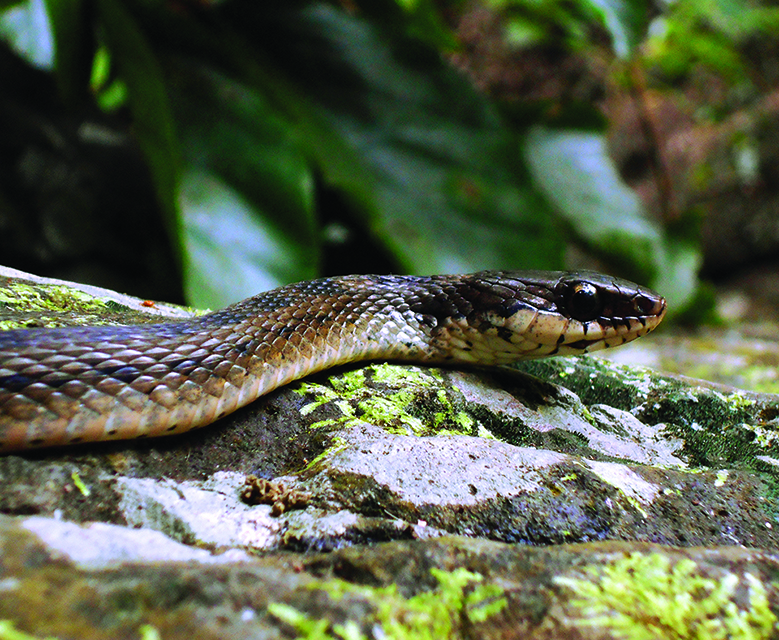A sanctuary. That is what I think a garden is – or should be. And not just for myself, but also for the animals who use it as a place to hunt, hide, or simply pass through. I have had many non-human garden visitors in the past, from fireflies and dragonflies to butterflies, and moths and scorpions; from centipedes and spiders to geckos and skinks; and even birds, such as bulbuls, sunbirds, orioles, and scops owls. But one group that never failed to awaken my senses are the snakes.To see snakes is to catch a glimpse of a primeval and secretive world, but one that most people abhor and would rather deal with violently. Which is unfortunate, because snakes, too, are a part of nature with a niche to fill. But particularly in the Philippines where most people express acute anathema to serpents, these animals continue their existence with the never-ending risk of being indiscriminately killed.Having maintained two small gardens from two different locations that span almost two decades, I have had the pleasure of seeing snakes using my modest plant collection as their temporary homes. This is an account of those species that have been found in these gardens.

Gervais’ worm snake is a common, fossorial species. Like its name suggests, it is small – and it does eat earthworms.Unfortunately, a grossly exaggerated fear of snakes has resulted in people killing these very inoffensive snakes, with many believing – without any basis, of course – that these are just “babies” of larger, dangerous snakes.If only people would cross the bridge from being irrationally afraid to being true students of nature, then they might be able to appreciate these snakes’ highly iridescent scales and yellow bellies. In the garden, these little snakes are sometimes seen foraging amongst detritus during the early morning hours.

This subspecies of the paradise flying snake is endemic to the Philippines. While by no means rare, the snakes are quite infrequently encountered due to their preference for tree canopies. However, every now and then, one would descend to the ground, perhaps after a fall whilst pursuing a skink, or maybe just to search for water, particularly during the drier months. The flying snake is a very weakly venomous snake that actively avoids human encounters – I treat each encounter as a privilege due to the infrequency with which they are seen.Males are smaller and thinner, yet more colorful than females.

Known as “talbos-tubo” or “ahas-tubo” in Tagalog, D. luzonensis is a common snake in the lowlands and is frequently seen by people. Curiously, it is often described as being thoroughly green, though the green coloration is restricted only to the venter; the dorsum is a rich brown with bronzy overlay. The tongue is a vivid red.I often encounter these snakes in my little garden during the daylight hours, basking under the sun, but would usually glide unobtrusively upon the first sight of a human form. They are, however, more easily approached in the early morning when temperatures are cooler.

This species is visually distinguished from D. luzonensis by its dorsal color which is more bronze than brown, its lighter build, and the lack of a median stripe underneath the tail.This is an infrequent visitor to my garden compared to its congener. My most recent sighting was that of a juvenile – shown here – which I found on my dining table. They were released in the garden.

This snake appears to be a twig mimic and looks like a junior version, in form and coloration, of the highly venomous bird snakes of Africa (Thelotornis). The similarity even extends to the pupils being vertically oriented. However, Dryophiops are smaller and have very weak venom. Disposition-wise, these are among the calmest snakes I have ever come across, and they seem to be fully confident of their ability to blend in with their surroundings that even when held would not initiate a flight response. These diurnal snakes are not all defensive.Recent studies have suggested that this species is becoming more and more uncommon in rural areas, and that may be an artifact of their being easily spotted and killed by fearful humans.Within my own neighborhood, I witnessed how a teenager whacked one with bravado, perhaps in an attempt to win the favor of one of his two female companions. When I arrived at the scene, I saw the snake squirming but already fatally wounded with a broken neck and several snapped-off points along its backbone. Reprimanding the culprit offered no comfort to the snake, which expired soon thereafter.

This is a snake rather common in my place. One time, I even saw a juvenile scaling my bedroom wall in a remarkable, gravity-defying stunt. The highly arboreal green ratsnake is a defensive snake if cornered. This beautiful snake preys on rodents and birds. An impressive sight as they lay coiled on tree branches.

This is perhaps the most common – or at least the most commonly seen – snake in the Philippines. Their proclivity for staying inside homes has earned them the name “ahas-bahay.” and the fact that they are often accidentally discovered during the day when they are inactive has also given rise to the alternative name “ahas-tulog.” These wolf snakes – so-named due to their dentition that consists of six enlarged, non-venom conducting fangs – can have a repertoire of defensive displays when antagonized. When fleeing is not an option, the snakes may coil and attempt to hide their heads within while shaking the tail very vigorously in an effort to draw attention away from the vulnerable head. They can and will bite if given the opportunity and will also eject smelly musk for good measure.Leaving them alone is the most sensible course of action.

On a few occasions, juvenile or hatchling Philippine cobras have also been found. These were duly ignored or transferred to somewhere safe. Photo here shows one such juvenile. I strongly advise against the handling of such highly venomous species, except by experienced herpetologists and herpetoculturists. I have seen at least one adult use the garden to pass by. At this point, I would like to mention that I took care of my nephew for one full year when he was five, and he would often play in the garden. He is a teenager now and absolutely has no ill-feeling toward snakes. One reason often mentioned by those who kill venomous snakes is that they want to avoid any future mishap with humans. It does not make any bit of sense to me. If people want to avoid accidents, then they should be taking precautionary measures; otherwise, they might as well smash vehicles, too, to avoid being hit on the road.Cobras’ notoriety is disproportionately overblown. My years of experience with them has been that they are only too wary to attract attention from larger animals, humans included. Cobras sensibly slide away silently and would only hood up in defense, as any other animal, because they have the right to do so once they feel their life being threatened.

An extra-limital snake in the garden. The genus Oligodon are collectively called “kukri snakes” due to the enlarged fangs located at their rear upper maxilla, which they use for slicing open eggs – kukris are large, recurved knives used widely within the Indian subcontinent. The fangs are non-venom conducting. These secretive snakes burrow using their broadened rostral scales.When picked up or disturbed, the snakes make sudden jerking movements. The genus Oligodon has gained notoriety for being among those snakes who are impossible to restrain by holding the jaws. Stiletto snakes – also called mole vipers (genus Atractaspis) are perhaps the most well-known in this respect. Oligodons are otherwise harmless and keep to themselves when left alone.

Known in Tagalog as “mamamalaka” due to their predisposition for preying on frogs, R. spilogaster is a cheeky snake common in the lowlands, particularly those that are fringed by bodies of water. Not surprisingly, their prey spectra consists of fishes and frogs; juveniles feed on earthworms. This is another snake with feeble venom potency – so weak, in fact, that like the snakes discussed above, the prey is swallowed alive as the venom appears to be unable to fully quiet struggling prey. A curiosity of these snakes is their reluctance to resort to biting when held or aggravated. Rather, they empty their cloacal contents in an impressive display of stink – it takes a few washings for the olfactory memory to fade. In the garden, I would sometimes see snakes of different ages hiding beneath broken pots. When not provoked, these would stay in their coils and I would promptly return their makeshift shelter as carefully and slowly as I could. In my former residence where flooding is a normal consequence of heavy rains, these snakes would swim to higher ground, including my garden. Of course, they are welcome to stay for as long as they want.

OTHER SLITHERING FRIENDs
Apart from these snakes, I also have had reticulated pythons (Malayopython reticulatus) and a single brown ratsnake (Coelognathus erythrura manillensis) lounge in the garden. The former are mostly seen after heavy flooding; one can only guess how many are killed by neighbors simply because the snakes are fleeing for their lives and they ended up in the wrong homes. The Brahminy blind snake (Ramphotyphlops brahminus) is of cosmopolitan distribution, and was spread across the world supposedly via plant imports for the horticulture industry. Quite surprisingly, these are very rarely encountered in the garden. As with Calamaria, these are habitually mistaken to be the young of some dangerous snake and are often duly crushed.
SNAKES ARE FRIENDS
In closing, I hope that today’s gardeners begin to see their gardens as sanctuaries for animals, too, snakes including. The fact that I do not use pesticides and the like means that mine is alive in every sense of the word. From ants and tiny spiders to dragonflies and emerald skinks who lay their eggs in hanging pots to snakes who hunt them down, my garden is more than a mere collection of





